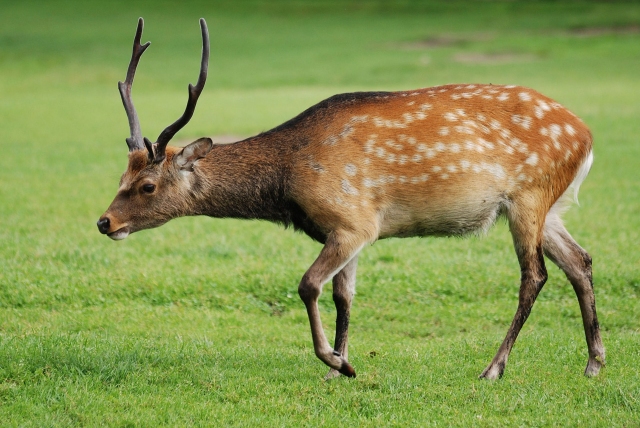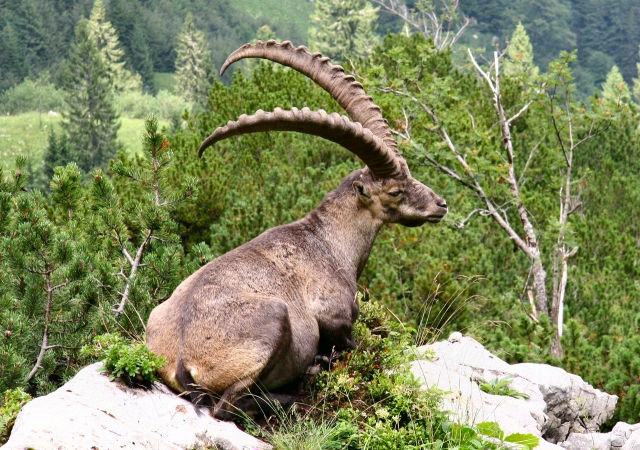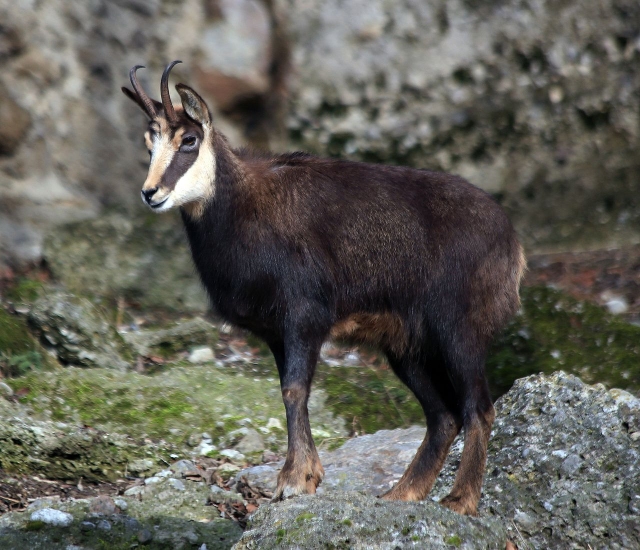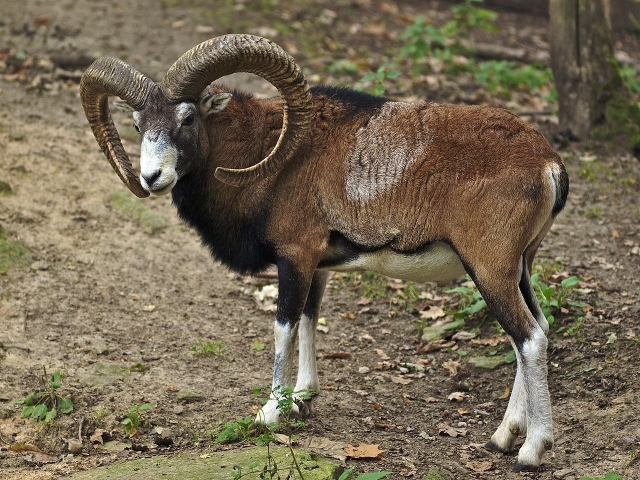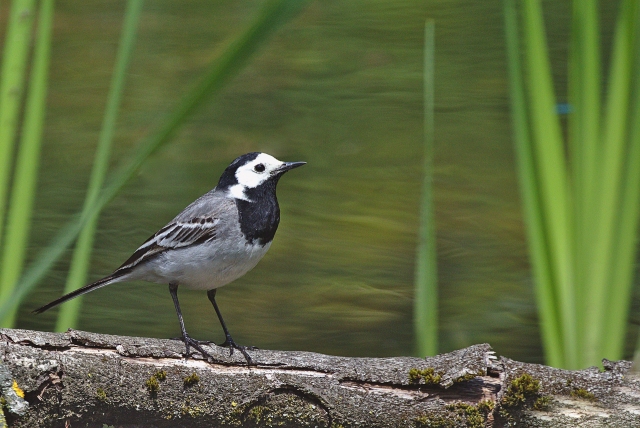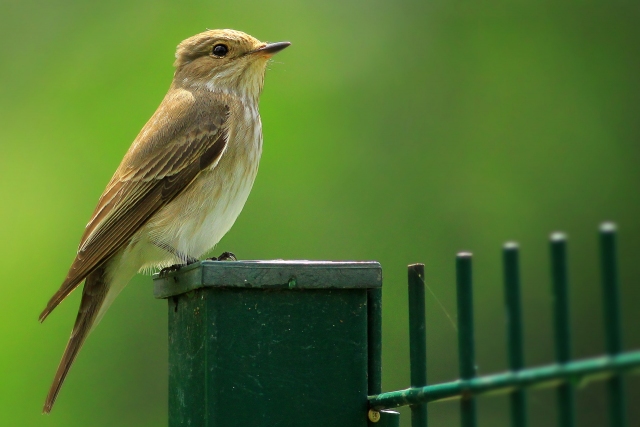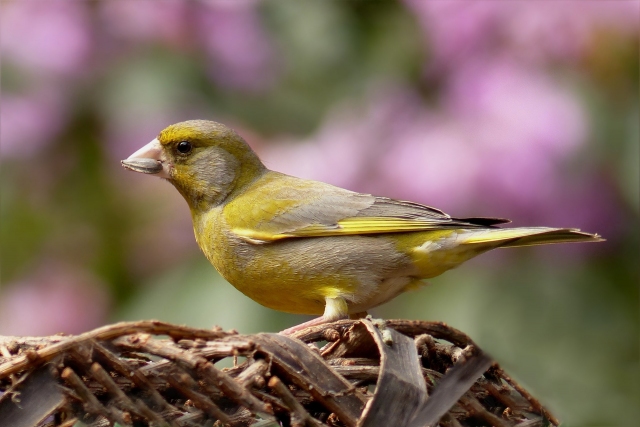Florian Heigl
Fallow deer
Description
The fallow deer is significantly larger than the roe deer, but smaller and above all lighter than a red deer. The European subspecies has a snout-vent length of 120 to 140 cm, a scut (tail) about 20 cm long and a shoulder height of 80 to 100 cm. The weight of males usually varies between 53 and 90 kg, very heavy males can reach a weight of 110 kg in exceptional cases.
The colouration of the coat is seasonally and individually very variable. In normally coloured individuals, the summer coat is light rusty brown with conspicuous white patches. These rows of spots start almost at the rear edge of the thighs and extend over the sides of the rump and the back to the base of the neck. A dark dorsal stripe runs down the middle of the back, which in the European fallow deer continues to the tip of the tail. The dorsal stripe is bordered on both sides by a white spotted line on the back. A conspicuous horizontal, light-coloured line runs down the middle of the side of the body. The underparts of the belly and the legs are pale and self-coloured, the neck is self-coloured pale rusty brown. The so-called mirror (bright spot around the anus) is bordered by a black rim, so that with the dark tail a vivid pattern of the rear part is created. In winter, the fallow deer is brown-grey on the head, neck and ears, blackish on the back and sides, and ash-grey on the underpart. The spotting is then only vaguely visible.
Habitat
The fallow deer prefers sparse forests with extensive meadows, but is generally very adaptable, so that it can be found in almost all regions of Europe. Ideal fallow deer territories have a dense mosaic of woodlands and fields, with the forest predominantly composed of deciduous trees. The soil is rich in nutrients and produces lush shrub vegetation. The proportion of forest in the respective habitat does not have to be very large, because fallow deer need the forest primarily as cover, but not as a food source.
In Austria, fallow deer are almost exclusively found in enclosures, but can be encountered sporadically.
The text is a translation of an excerpt from Wikipedia (https://de.wikipedia.org/wiki/Damhirsch). On wikipedia the text is available under a „Creative Commons Attribution/Share Alike“ licence. Status: 23 September 2021
Red deer
Description
The red deer is one of the larger deer species, although there are sometimes considerable differences in body size between the subspecies. As a rule, the snou-vent lenght of males is 180 to 205 cm, that of females 165 to 180 cm, plus a tail 14 to 16 cm long in each case. Accordingly, the shoulder height is 105 to 130 and 95 to 115 cm respectively. The weight also varies considerably. The red deer has a broad chest, a relatively long, slender neck and a head that narrows towards the front. The tail is 10 to 27 cm long and narrows towards the tip. The red deer has medium-sized eyes (lights), pointed ears (eaves) half the length of the head and high slender feet (legs).
The colouring of the coat varies depending on the season, sex and age. Apart from the hairs on the mouth, all hairs are changed twice a year.
In Central Europe, the summer coat begins to grow in May to June. It has a reddish-brown hazel tone, characteristic of the red deer. In September to October, the majority of red deer change to a grey-yellow to grey-brown winter coat. In older deer, this change of coat can also begin as early as August. Compared to the summer coat, the winter coat is shaggier and has denser woolly hair under the awns. The calves' coat is reddish-brown with dense rows of white spots. These so-called calf spots are covered by regrowing hair during the summer months.
Many red deer have an dorsal stripe from the nape of the neck to the base of the tail. It is characteristic for all red deer that the back of the thigh is clearly different from the rest of the coat colour. The colouring of this so-called mirror is greyish white to yellowish white. The mirror is framed by blackish hairs and thus clearly set off from the rest of the back.
Habitat
Red deer prefer habitats with a close network of structure-rich forests, thickets and large open clearings. However, they can also survive well in primeval forest-like closed and scarce food forest areas or almost treeless countryside, such as in Scotland. Since the red deer occurs both in the cold high altitudes of the Alps, in the wet river floodplains of south-eastern Europe and in the hot and dry lowlands of Spain, it can be considered an adaptable species as far as its habitat requirements are concerned.
In Central Europe, the red deer's free choice of habitat is severely restricted due to dense human settlement. Since the red deer avoids humans, it is mainly found in forest biotopes here and concentrates there on the forest areas where it is least exposed to contact with humans. Known old long-distance crossings of red deer between red deer areas are not given any special protection. From a biological point of view, today's Central European red deer areas are island-like refuges. The exchange between the different red deer areas, which is necessary for the genetic diversity of the red deer population, is not guaranteed either by law or by spatial planning. There are also no migrations between winter and summer ranges, which were originally characteristic for this deer and played a major role for its food acquisition. In individual hunting grounds, this can lead to a high density of deer with corresponding damage to the forest.
The text is a translation of an excerpt from Wikipedia (https://de.wikipedia.org/wiki/Rothirsch). On wikipedia the text is available under a „Creative Commons Attribution/Share Alike“ licence. Status: 23 September 2021
Japanese deer
Description
Japanese deer are significantly smaller than red deer and are roughly the same size as fallow deer. They reach a snout-vent lenght of between 95 and 140 cm in male specimens. The height at the withers/shoulder is 64 to 100 cm, the tail is 7.5 to 13 cm long. They weigh up to 80 kilograms.
The summer coat of the Japanese deer is usually reddish brown with numerous white spots arranged in seven to eight longitudinal rows. In winter, these spots fade and are sometimes hardly noticeable, while in summer they contrast markedly with the rest of the coat colour. Japanese deer usually wear their summer coat from the end of May. They show their winter coat from September onwards.
The back of the thigh is clearly different from the rest of the coat colour. This so-called mirror is whitish and framed by darker hairs. The end of the tail is also white, with a dark line running down the middle.
There is a possibility of confusion with the fallow deer, which also has a reddish-brown summer coat with a spotted pattern. However, the shade of red in the most common colour morph of the fallow deer is a rusty shade. Older fallow deer can be distinguished from male Japanese deer by their antlers, as fallow deer develop palms.
Habitat
Japanese deer are a very adaptable species of deer. They prefer forests with a dense undergrowth and are also found in wetlands.
The text is a translation of an excerpt from Wikipedia (https://de.wikipedia.org/wiki/Sikahirsch). On wikipedia the text is available under a „Creative Commons Attribution/Share Alike“ licence. Status: 19. October 2021
Alpine ibex
Description
An alpine ibex has an average head length of 150 cm and a shoulder height of 90 cm. Does weight about 40 kg, whereas bucks can weigh over 100 kg. The buck has imposing, curved horns (up to 1 m long), while the doe has only short, barely curved horns. The bucks have a goatee. Bucks have a dark brown coat in summer; the females' coat is more reddish or golden brown. In winter, the fur of both sexes turns greyish.
Habitat
In the Alps, the ibex lives at the altitude between the forest and ice line. It climbs up to altitudes of 3500 m. In winter, however, it stays at lower altitudes than in summer, and even in summer it often descends to alpine meadows to feed, while it goes to the high altitudes to spend the night.
The text is a translation of an excerpt from Wikipedia (https://de.wikipedia.org/wiki/Alpensteinbock). On wikipedia the text is available under a „Creative Commons Attribution/Share Alike“ licence. Status: 19 October 2021
Chamois
Description
Adult chamois have a snout-vent length of 110 to 130 cm, a tail up to eight cm long, a height at the withers of 70 to 85 cm and a weight of 25 to 40 kg (females) or 35 to 50 kg (males). Chamois have a strong but stocky build. The slender neck carries a short head that narrows strongly towards the snout. Both sexes have horns, also called "Krucken" or "Krickel". These grow up to 25 cm long and are rounded. They are circularly notched at the root, straight upwards and curved backwards at the tip. Unlike the antlers of deer and roe deer, the horns are not shed in winter. The pointed ears of chamois are about half the length of the head.
The chamois has relatively long, strong legs with relatively large hooves.
In summer the chamois is a dirty reddish brown, pale reddish yellow on the underpart, with a blackish brown eel line on the back, pale yellow on the throat and whitish yellow on the neck. The back of the thighs is white, the tail black on the underpart and at the tip. A black longitudinal band runs from the ears over the eyes.
In winter the chamois is dark brown or brown-black above, white on the belly, yellowish white on the feet and head, and slightly darker on the crown and snout. Both coats blend imperceptibly into each other.
Habitat
The chamois depends on steep, if possible partly rocky terrain for its habitat. This is where its physical abilities come into their best play. For example, a comparatively large heart, a high proportion of oxygen-binding red blood cells and the special construction of the spreading hooves enable chamois to move safely and perform well under these conditions. The slope of the landscape is also used to stay in a suitable microclimate at all times, especially since temperatures as low as 12 degrees are considered rather unpleasant by the animals. Whether the terrain is forested is basically of no central importance. In the Alps, chamois tend to stay above the forest belt at altitudes between 1500 and 2500 m. The scarcity of food forces them to stay in the forest. Food shortages force them to descend to lower - forested - altitudes in winter.
The text is a translation of an excerpt from Wikipedia (https://de.wikipedia.org/wiki/Gämse). On wikipedia the text is available under a „Creative Commons Attribution/Share Alike“ licence. Status: 19 October 2021
Moufflon
Description
European moufflons have a body length of up to 120 cm, a shoulder height of 90 cm, a weight of 25 to 40 kg for sheep, 35 to 55 kg for rams. The European moufflon has a smooth coat, the rams are chestnut brown in summer, usually with a whitish saddleback, the sheeps are brownish. In winter both sexes are darker. The rams have snail-shaped horns up to 80 cm long.
Habitat
In Central Europe, European moufflons live in deciduous and mixed forest areas both in the lowlands and in the low mountain ranges, also preferring dry and stony soils.
The text is a translation of an excerpt from Wikipedia (https://de.wikipedia.org/wiki/Europäischer_Mufflon). On wikipedia the text is available under a „Creative Commons Attribution/Share Alike“ licence. Status: 19 October 2021
White wagtail
Description
The white wagtail is a slender, rather high-legged songbird with a long tail that is constantly in bobbing motion. The tail accounts for about 9 cm of the 16.5-19 cm body length. The weight is about 25 g. The beak, like the legs and feet, is black, and in basic plumage it has a horn-coloured base.
nuptial plumage
In nuptial plumage, the male's forehead is white except for the middle part of the crown, as is a section behind the eye and the sides of the head and neck. The back of the head and neck are shiny black, as are the chin, throat and forechest, and are usually cleanly contrasted with the white parts of the face and the grey back. The rump is slate to black-grey as are the uppertail coverts, of which the lateral ones on the outer vane are fringed with white. The grey of the shoulder feathers blends into the pure white of the underparts on the breast sides and flanks. The undertail coverts are also white. The tail is glossy black and, as the two outer pairs of feathers are black only at the base and inner vane, shows broad white outer edges, which are particularly noticeable when the bird flies up. In addition, the middle pair of tail feathers is narrowly fringed with white. The wing feathers are blackish brown with white to light grey fringes. The primaries are finely fringed with white, as are the primary coverts and the wing feathers. On the secondaries the outer edges become broader towards the tertials and take up a large part of the outer vane on the latter. Here they are dirty white to light grey. The greater coverts are similarly fringed, the inner ones bearing an extended white, stepped tip. The middle coverts show a broad lace fringe. The underwing coverts are dirty white.
The nuptial dress of the female is similar to that of the male, but the white parts of the face are usually not so distinct from the black and are partly greyish mottled. The black colouring of the nape blends into the grey of the back and is not sharply defined as in the male. In addition, the wing plumage is usually not as contrastingly brightly fringed as in the male. In some females the head markings may be as or similar to those of the male.
basic plumage
The basic plumage of adult birds lack the black areas on the head. They are limited to a crescent-shaped band on the breast and a partly distinct cheek patch. The forehead is dirty white to grey. The head, neck, ear coverts and cheeks are grey. The facial area may have a yellowish tinge. The rest of the plumage corresponds to the nuptial plumage. The male differs from the female only in the darker crown interspersed with black feathers.
juvenile plumage
In juvenile plumage the upperparts are predominantly grey, the back a little lighter, the top of the head and the nape of the neck a little brownish. On top behind the eye there is an over-eye stripe, which like the sides of the neck, the chin and the throat are dirty white. The ear coverts are dark dirty yellow. A crescent-shaped chest band as well as a chin stripe emanating from it are brown-black to yellow-brown. The sides of the breast are grey, the underparts white. Wing and tail plumage resemble adult plumage, but fade quickly and then show little contrast between centres and fringes.
Habitat
The white wagtail inhabits semi-open and open landscapes and is found practically everywhere except in closed forest areas and densely built-up urban centres. Important here are unvegetated or short-grassed ground areas, which are needed for foraging, and the same surrounding, higher structures such as buildings or groups of trees, which have suitable niches for nesting. Preference is given to sites near water bodies - the primary habitat probably consists of muddy, sandy, gravelly or stony banks, as they occur especially in large riverine landscapes. Today, the cultural landscape offers corresponding areas on a large scale, such as pastures, fields, farm roads, asphalted areas, construction and gravel pits or open fallow and ruderal areas. The white wagtail is therefore particularly common in the vicinity of farming villages, where there is also an abundant supply of nesting opportunities. In the mountains, the species can still be found a good distance above the tree line at altitudes of up to 3000 metres.
Outside the breeding season, white wagtails can be found mainly at water bodies of all kinds, but also on ploughed fields. Communal roosting sites are usually on water surfaces in reeds or willow scrub, but also in other sheltered places. Especially birds wintering in more northerly latitudes like to seek out brightly lit places in urban and residential areas at night, which have a warmer microclimate.
The text is a translation of an excerpt from Wikipedia (https://de.wikipedia.org/wiki/Bachstelze). On wikipedia the text is available under a „Creative Commons Attribution/Share Alike“ licence. Status: 19 October 2021
Tree sparrow
Description
The tree sparrow is up to 14 cm tall and weights 20 to 24 grams. The wing length is between 6.8 and 7.4 cm in males and between 6.6 and 7.1 cm in females. The male tail measures 4.8 to 5.8 cm, while the female tail measures between 5 and 5.6 cm.
The tree sparrow is somewhat more cleanly marked than the house sparrow and is overall somewhat smaller and slimmer than the latter. The top of the head and the nape of the neck are brown, the throat bears a small black throat patch. The cheeks are white with a black spot in the ear area. The pale collar is almost closed at the nape. The top of the body is brownish with darker longitudinal stripes, which are particularly noticeable on the back and shoulders. The rump is yellowish brown, the belly and breast are brownish grey. The wings have two white bands.
Juveniles resemble adults but are more greyish brown on the top of the head. The upperpart is paler with longitudinal grey stripes, the cheek and throat patches are still sooty grey. They undergo a full moult about five to eight weeks after fledging and show their first adult plumage after an average of 77 days. The nestlings are initially naked. They have pink skin, and the throat and tongue are also pink. The beak bulges are pale yellow.
Habitat
The habitat is sparsely wooded regions, forest edges, field margins, hedgerows, avenues, gardens and the fringes of settlements. In western Europe in particular, the tree sparrow is less of a synanthropic bird than the house sparrow. However, it is increasingly penetrating towns and villages and occupying the niche of the increasingly rare house sparrow.
The text is a translation of an excerpt from Wikipedia (https://de.wikipedia.org/wiki/Feldsperling). On wikipedia the text is available under a „Creative Commons Attribution/Share Alike“ licence. Status: 20 October 2021
European spotted flycatcher
Description
European spotted flycatchers are quite small, slender songbirds with rather large heads, relatively long wings and long tails. They are overall rather plain grey-brown and have no conspicuous markings. The sexes are equally coloured.
With a body length of 13.5 to 15 cm, the species is about the size of a house sparrow. In adult birds, the entire upperpart of the rump, including the hindneck and head, as well as the lesser coverts are a solid dark to greyish brown, only the plumage on the forehead and front upper part of the head is a patchier brown with dark shaft stripes and pale fringes. Wings and tail feathers are darker grey. The primaries and the tail feathers have narrow brownish fringes on the outer plumes, the secondaries are broader and have more whitish fringes. In fresh plumage, the large and medium coverts show beige tips and similarly coloured fringes, with increasing wear these light parts become more and more indistinct. The throat and the entire underpart of the rump as well as the undertail coverts are dirty white, the throat and middle of the breast are finely streaked on this ground, the light brownish overcast breast sides and flanks are more strongly dark streaked. The iris is dark brown. The rather long beak is blackish horn-coloured, the base of the lower beak is lightened. The legs are black.
In juvenile plumage the upperparts are more brown with pale rusty beige to isabelline spots. The secondaries and the greater coverts have reddish brown fringes. The underpart of the rump has a dark spotted pattern on an isabelline background and hardly any stripes.
Habitat
The European spotted flycatcher is bound to taller trees, which allow it to use free airspace for hunting insects in the air and on the ground due to a large number of perching places. It therefore primarily inhabits sparse areas in forests of all kinds up to copses, but also parks, cemeteries, gardens and avenues in villages and towns. Buildings enrich the habitat by providing nesting sites and an increased supply of insects due to heat radiation. In Central Europe, probably the greater part of the population breeds in the area of human settlements, older parks usually have the highest breeding pair densities.
The text is a translation of an excerpt from Wikipedia (https://de.wikipedia.org/wiki/Grauschnäpper). On wikipedia the text is available under a „Creative Commons Attribution/Share Alike“ licence. Status: 20 October 2021
Eurasian greenfinch
Description
With a body length of 14 to 16 cm, the Eurasian greenfinch is about as large as the house sparrow. The body, head and beak are strikingly strong. The beak is light horn-coloured. The outer plumes of the primaries are yellow, resulting in a greenish-yellow wing patch. When the wing is folded, the outer edge is also distinctly yellow. The parts of the tail feathers close to the body are also yellow.
The male is yellow-green on the underparts and grey-green on the upperparts. The rump is lighter green. The cheeks, neck, nape and greater coverts are grey, the flanks are light grey. On the wings there is a grey wing patch in the area of the secondaries. The tips of the wings and tail feathers are dark. The throat is dirty yellow. The legs are flesh coloured.
The female is overall much duller and less yellow in colour than the male. The entire body plumage is faintly streaked longitudinally. Her upperparts and head are brownish, the underpart of the rump is faintly greenish-grey. The throat is pale, the cheeks brown.
The juvenile plumage is distinctly lighter, the underpart of the body whitish with light grey longitudinal stripes, the upper side washed-out grey-brown and faintly longitudinally striped. The yellow colouring of the wing is very indistinct. There is a pale grey area around the eye. The greater coverts have broad, beige-coloured terminal seams. In females and juveniles the legs are dark sandy. The iris is dark in all.
Habitat
The Eurasian greenfinch is originally a resident of sparse tree stands, clearings or open areas bordering forest edges, as well as riverbanks and copses. Today, it mainly inhabits a wide variety of human settlements: From individual farms and hamlets with scattered orchards to large city centres with parks or cemeteries, provided there are at least individual trees, rows of trees or greened house facades.
The text is a translation of an excerpt from Wikipedia (https://de.wikipedia.org/wiki/Grünfink). On wikipedia the text is available under a „Creative Commons Attribution/Share Alike“ licence. Status: 03 November 2021



